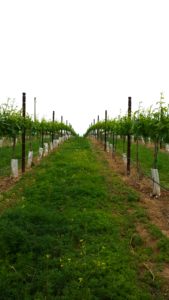
Rome was not built in a day and neither was the family farm. Lillian and George continued to make improvements to their homestead over time. Between 1918 and 1919 they were able to build a barn, which allowed them to keep more livestock. They started to raise a small herd of dairy cows which proved to be helpful. Like with most start-up farms, money was tight so Lilly and George sold their surplus milk and cream. We suspect having fresh cream for their morning coffee was an added perk too! 
Lilly and George didn’t live lavish lives but they loved their land and they were willing to make the most of it. They experimented with raising different crops. They were the first family to plant apples in the area and continued to plant various fruit trees over the years. Surprisingly one of their first crops that brought them some financial windfall was a bumper crop of tomatoes! You can see (below) a picture of the field of young tomato vines, they covered in white paper tents to protect the plants until the danger of frost was past. 


 Any Idaho agricultural story, even a story about wine, has to begin with potatoes. The state turns out 13 billion pounds of spuds a year. Go ahead, read it again if you have to: 13 billion pounds.
Any Idaho agricultural story, even a story about wine, has to begin with potatoes. The state turns out 13 billion pounds of spuds a year. Go ahead, read it again if you have to: 13 billion pounds.